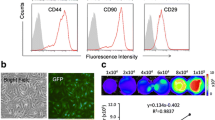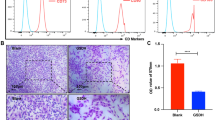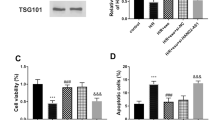Abstract
Background
Bone marrow mesenchymal stem cells (BMSCs) transplantation therapy providing a great hope for the recovery of myocardial ischemic hypoxic injury. However, the microenvironment after myocardial injury is not conducive to the survival of BMSCs, which limits the therapeutic application of BMSCs. Our previous study has confirmed that the survival of BMSCs cells in the glucose and serum deprivation under hypoxia (GSDH) is increased after Andrographolide (AG) pretreatment, but whether this treatment could improve the effect of BMSCs in repairing of myocardial injury has not been verified.
Methods and result
We first treated H9C2 with GSDH to simulate the microenvironment of myocardial injury in vitro, then we pretreated rat primary BMSCs with AG, and collected conditioned medium derived from BMSCs (BMSCs-CM) and conditioned medium derived from AG-pretreated BMSCs (AG-BMSCs-CM) after GSDH treatment. And they were used to treat H9C2 cells under GSDH to further detect oxidative stress and metabolic changes. The results showed that AG-BMSCs-CM could be more advantageous for cardiomyocyte injury repair than BMSCs-CM, as indicated by the decrease of apoptosis rate and oxidative stress. The changes of mitochondria and lipid droplets results suggested that AG-BMSCs-CM can regulate metabolic remodeling of H9C2 cells to repair cell injury, and that AMPK was activated during this process.
Conclusions
This study demonstrates, for the first time, the protective effect of AG-BMSCs-CM on GSDH-induced myocardial cell injury, providing a potential therapeutic strategy for clinical application.






Similar content being viewed by others
Data availability
All data generated or analyzed during this study are included in this published article.
References
Twerenbold R, Jaeger C, Rubini Gimenez M et al (2016) Impact of high-sensitivity cardiac troponin on use of coronary angiography, cardiac stress testing, and time to discharge in suspected acute myocardial infarction. Eur Heart J 37:3324–3332. https://doi.org/10.1093/eurheartj/ehw232
Sun T, Dong Y-H, Du W et al (2017) The role of MicroRNAs in myocardial infarction: from molecular mechanism to clinical application. Int J Mol Sci. https://doi.org/10.3390/ijms18040745
Qian Q, Qian H, Zhang X et al (2012) 5-Azacytidine induces cardiac differentiation of human umbilical cord-derived mesenchymal stem cells by activating extracellular regulated kinase. Stem Cells Dev 21:67–75. https://doi.org/10.1089/scd.2010.0519
Cheng P, Zeng W, Li L et al (2016) PLGA-PNIPAM microspheres loaded with the gastrointestinal nutrient NaB ameliorate cardiac dysfunction by activating Sirt3 in acute myocardial infarction. Adv Sci 3:1600254. https://doi.org/10.1002/advs.201600254
Mican J, Toul M, Bednar D, Damborsky J (2019) Structural biology and protein engineering of thrombolytics. Comput Struct Biotechnol J 17:917–938. https://doi.org/10.1016/j.csbj.2019.06.023
Blackwood EA, Azizi K, Thuerauf DJ et al (2019) Pharmacologic ATF6 activation confers global protection in widespread disease models by reprograming cellular proteostasis. Nat Commun 10:187. https://doi.org/10.1038/s41467-018-08129-2
Al Madhoun A, Marafie SK, Haddad D et al (2020) Comparative proteomic analysis identifies EphA2 as a specific cell surface marker for Wharton’s jelly-derived mesenchymal stem cells. Int J Mol Sci. https://doi.org/10.3390/ijms21176437
Chen X (2015) Mesenchymal stem cells improve cardiac function after myocardial infarction in rats without long-term survival: a serial 7.0T MRI study. J Cardiovasc Magn Reson. https://doi.org/10.1186/1532-429X-17-S1-P132
Gao X, Song L, Shen K et al (2014) Bone marrow mesenchymal stem cells promote the repair of islets from diabetic mice through paracrine actions. Mol Cell Endocrinol 388:41–50. https://doi.org/10.1016/j.mce.2014.03.004
Kato J, Kamiya H, Himeno T et al (2014) Mesenchymal stem cells ameliorate impaired wound healing through enhancing keratinocyte functions in diabetic foot ulcerations on the plantar skin of rats. J Diabetes Complicat 28:588–595. https://doi.org/10.1016/j.jdiacomp.2014.05.003
Ma H, Lam PK, Tong CSW et al (2019) The neuroprotection of hypoxic adipose tissue-derived mesenchymal stem cells in experimental traumatic brain injury. Cell Transplant 28:874–884. https://doi.org/10.1177/0963689719855624
Abdelwahab S, Elsebay SAG, Fouli Gaber M, Abdel-Hafez SMN (2021) Comparative study between bone marrow mesenchymal stem cell and their conditioned medium in the treatment of rat model of parkinsonism. J Cell Physiol 236:440–457. https://doi.org/10.1002/jcp.29872
Yang M, Cui Y, Song J et al (2021) Mesenchymal stem cell-conditioned medium improved mitochondrial function and alleviated inflammation and apoptosis in non-alcoholic fatty liver disease by regulating SIRT1. Biochem Biophys Res Commun 546:74–82. https://doi.org/10.1016/j.bbrc.2021.01.098
Chu X, Xu B, Gao H et al (2019) Lipopolysaccharides improve mesenchymal stem cell-mediated cardioprotection by MyD88 and stat3 signaling in a mouse model of Cardiac Ischemia/Reperfusion Injury. Stem Cells Dev 28:620–631. https://doi.org/10.1089/scd.2018.0213
Lin M, Liu X, Zheng H et al (2020) IGF-1 enhances BMSC viability, migration, and anti-apoptosis in myocardial infarction via secreted frizzled-related protein 2 pathway. 1–16
Li J, Huang L, He Z et al (2021) Andrographolide suppresses the growth and metastasis of Luminal-Like breast Cancer by inhibiting the NF-κB/miR-21-5p/PDCD4 signaling pathway. Front Cell Dev Biol 9:643525. https://doi.org/10.3389/fcell.2021.643525
Su H, Mo J, Ni J et al (2020) Andrographolide exerts antihyperglycemic effect through strengthening intestinal barrier function and increasing microbial composition of akkermansia muciniphila. Oxidative Med Cell Longev. https://doi.org/10.1155/2020/6538930
Agust R, Alarc P, Quiroga J et al (2021) Andrographolide, an anti-inflammatory multitarget drug: all roads lead to cellular metabolism. Molecules 26:1–17
Sun Y, Xu H, Tan B et al (2022) Andrographolide protects bone marrow mesenchymal stem cells against glucose and serum deprivation under hypoxia via the NRF2 signaling pathway. Stem Cell Res Ther 13:1–18. https://doi.org/10.1186/s13287-022-03016-6
Gibb AA, Hill BG (2018) Metabolic coordination of physiological and pathological cardiac remodeling. Circul Res 123:107–128. https://doi.org/10.1161/CIRCRESAHA.118.312017
Tian Z-H, Weng J-T, Shih L-J et al (2018) Arecoline inhibits the growth of 3T3-L1 preadipocytes via AMP-activated protein kinase and reactive oxygen species pathways. PLoS ONE 13:e0200508. https://doi.org/10.1371/journal.pone.0200508
Liu M-H, Lin X-L, Guo D-M et al (2016) Resveratrol protects cardiomyocytes from doxorubicin-induced apoptosis through the AMPK/P53 pathway. Mol Med Rep 13:1281–1286. https://doi.org/10.3892/mmr.2015.4665
Lee HJ, Lee JK, Lee H et al (2012) Human umbilical cord blood-derived mesenchymal stem cells improve neuropathology and cognitive impairment in an Alzheimer’s disease mouse model through modulation of neuroinflammation. Neurobiol Aging 33:588–602. https://doi.org/10.1016/j.neurobiolaging.2010.03.024
Zhang Z, Sheng H, Liao L et al (2020) Mesenchymal stem cell-conditioned medium improves mitochondrial dysfunction and suppresses apoptosis in okadaic acid-treated SH-SY5Y cells by extracellular vesicle mitochondrial transfer. J Alzheimer’s Dis 78:1161–1176. https://doi.org/10.3233/JAD-200686
Hao P, Liang Z, Piao H et al (2014) Conditioned medium of human adipose-derived mesenchymal stem cells mediates protection in neurons following glutamate excitotoxicity by regulating energy metabolism and GAP-43 expression. Metab Brain Dis 29:193–205. https://doi.org/10.1007/s11011-014-9490-y
Wang Q-L, Wang H-J, Li Z-H et al (2017) Mesenchymal stem cell-loaded cardiac patch promotes epicardial activation and repair of the infarcted myocardium. J Cell Mol Med 21:1751–1766. https://doi.org/10.1111/jcmm.13097
Sato M, Inohaya A, Yasuda E et al (2021) Three-dimensional human placenta-like bud synthesized from induced pluripotent stem cells. Sci Rep 11:14167. https://doi.org/10.1038/s41598-021-93766-9
Su VY-F, Lin C-S, Hung S-C, Yang K-Y (2019) Mesenchymal stem cell-conditioned medium induces neutrophil apoptosis associated with inhibition of the NF-κB pathway in endotoxin-induced acute lung injury. Int J Mol Sci. https://doi.org/10.3390/ijms20092208
Gnecchi M, He H, Noiseux N et al (2006) Evidence supporting paracrine hypothesis for akt-modified mesenchymal stem cell-mediated cardiac protection and functional improvement. FASEB J 20:661–669. https://doi.org/10.1096/fj.05-5211com
Sun T, Li H, Bai Y et al (2020) Ultrasound-targeted microbubble destruction optimized HGF-overexpressing bone marrow stem cells to repair fibrotic liver in rats. Stem Cell Res Ther. https://doi.org/10.1186/s13287-020-01655-1
Phunikom N, Boonmuen N, Kheolamai P et al (2021) Andrographolide promotes proliferative and osteogenic potentials of human placenta-derived mesenchymal stem cells through the activation of Wnt/β-catenin signaling. Stem Cell ResTher 12:1–13. https://doi.org/10.1186/s13287-021-02312-x
Wei Y, Peng S, Wu M et al (2014) Multifaceted roles of miR-1s in repressing the fetal gene program in the heart. Cell Res 24:278–292. https://doi.org/10.1038/cr.2014.12
Beaumont E, Southerland EM, Hardwick JC et al (2015) Vagus nerve stimulation mitigates intrinsic cardiac neuronal and adverse myocyte remodeling postmyocardial infarction. Am J Physiol Heart Circ Physiol 309:H1198–H1206. https://doi.org/10.1152/ajpheart.00393.2015
Aung LHH, Li R, Prabhakar BS, Li P (2017) Knockdown of Mtfp1 can minimize doxorubicin cardiotoxicity by inhibiting Dnm1l-mediated mitochondrial fission. J Cell Mol Med 21:3394–3404. https://doi.org/10.1111/jcmm.13250
Stanley WC, Recchia FA, Lopaschuk GD (2005) Myocardial substrate metabolism in the normal and failing heart. Physiol Rev 85:1093–1129. https://doi.org/10.1152/physrev.00006.2004
Depre C, Vanoverschelde JL, Taegtmeyer H (1999) Glucose for the heart. Circulation 99:578–588. https://doi.org/10.1161/01.cir.99.4.578
Mangi AA, Noiseux N, Kong D et al (2003) Mesenchymal stem cells modified with akt prevent remodeling and restore performance of infarcted hearts. Nat Med 9:1195–1201. https://doi.org/10.1038/nm912
Massimiliano G, Huamei H, Luis G, Nicolas N, Fulvio M, Rudolf de B et al (2009) Early beneficial Effects of bone marrow derived mesenchymal stem cells overexpressing akt on Cardiac Metabolism after myocardial infarction. Stem Cells 27:971–979. https://doi.org/10.1002/stem.12.Early
Ore A, Olayinka ET (2015) Influence of moxifloxacin on hepatic redox status and plasma biomarkers of Hepatotoxicity and Nephrotoxicity in Rat. Biochem Res Int 2015:192724. https://doi.org/10.1155/2015/192724
Wu J-W, Hu H, Hua J-S, Ma L-K (2022) ATPase inhibitory factor 1 protects the heart from acute myocardial ischemia/reperfusion injury through activating AMPK signaling pathway. Int J Biol Sci 18:731–741. https://doi.org/10.7150/ijbs.64956
Yuan Y, Shi M, Li L et al (2016) Mesenchymal stem cell-conditioned media ameliorate diabetic endothelial dysfunction by improving mitochondrial bioenergetics via the Sirt1/AMPK/PGC-1α pathway. Clin Sci 130:2181–2198. https://doi.org/10.1042/CS20160235
Ye L, Zhang X, Zhou Q et al (2021) Activation of AMPK promotes maturation of cardiomyocytes derived from human induced pluripotent stem cells. Front cell Dev Biol 9:644667. https://doi.org/10.3389/fcell.2021.644667
Russell RR 3rd, Li J, Coven DL et al (2004) AMP-activated protein kinase mediates ischemic glucose uptake and prevents postischemic cardiac dysfunction, apoptosis, and injury. J Clin Investig 114:495–503. https://doi.org/10.1172/JCI19297
Acknowledgements
Not applicable.
Funding
This work was supported by the National Natural Science Foundation of China (Grant Numbers 81970244).
Author information
Authors and Affiliations
Contributions
YS prepared the article and acquired the data. HX, BT and QY were involved in article preparation. HH, JZ and JT conceived and designed the project. HL analyzed and interpreted the data. YS and HH wrote the paper.
Corresponding author
Ethics declarations
Conflict of interest
The authors declare that they have no conflicts of interest.
Ethical approval
Not applicable.
Consent for publication
The authors agree to publication in the Journal.
Additional information
Publisher’s Note
Springer Nature remains neutral with regard to jurisdictional claims in published maps and institutional affiliations.
Supplementary Information
Below is the link to the electronic supplementary material.
11033_2023_8250_MOESM1_ESM.jpg
Supplementary material 1 (JPG 545.7 kb)—Fig. S1Schematic of the potential mechanism by whichAG-BMSCs-CM improves the anti-apoptosis and anti-oxidative stress effects ofcardiomyocyte under GSDH.
Rights and permissions
Springer Nature or its licensor (e.g. a society or other partner) holds exclusive rights to this article under a publishing agreement with the author(s) or other rightsholder(s); author self-archiving of the accepted manuscript version of this article is solely governed by the terms of such publishing agreement and applicable law.
About this article
Cite this article
Sun, Y., Xu, H., Tan, B. et al. Andrographolide-treated bone marrow mesenchymal stem cells-derived conditioned medium protects cardiomyocytes from injury by metabolic remodeling. Mol Biol Rep 50, 2651–2662 (2023). https://doi.org/10.1007/s11033-023-08250-6
Received:
Accepted:
Published:
Issue Date:
DOI: https://doi.org/10.1007/s11033-023-08250-6




